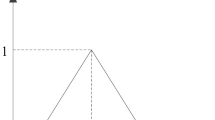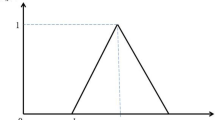Abstract
Occupational risk assessment (ORA) is a process that consists of evaluating, ranking, and classifying the hazards and associated risks arising in any workplace from the viewpoint of occupational health and safety. Many ORA methods have been proposed in the literature, from a single independent expert to participatory methodologies made by group decision and simple to complex ones. In this paper, a holistic ORA is presented, which uses two important multi-attribute decision methods named Bayesian Best-Worst Method (Bayesian BWM) and VIseKriterijumska Optimizacija I Kompromisno Resenje (VIKOR). Bayesian BWM is used to determine the importance weights of six different assessment criteria, which are the probability of hazardous event (P), frequency (F), severity (S), detectability (D), cost (C) and sensitivity not to use personal protective equipment (SNP). Since the classical BWM finds solution to the weights of a number of criteria from only one expert's judgment, Bayesian BWM is preferred in this paper (1) to enable participation of a group of experts, (2) to aggregate the preferences of these multiple experts into consensus without loss of information and (3) to follow a probabilistic way for solving the ORA problem. The hazards are then ranked by VIKOR. The approach is implemented in the ORA process of a textile production plant. Results of risk analysis showed that electricity hazard and associated risks constitute the highest risk ratings. These hazards arise from the product, process, human and working environment. The associated risks are evaluated, prioritized, and detailed control measures are proposed. This study made comparisons with the classical BWM-VIKOR approach to demonstrate the proposed approach's difference and practicality. Results can also help practitioners and risk analysts in formulating the improvement measures to increase the overall safety of the working environment further.








Similar content being viewed by others
References
Ahn J, Noh Y, Park SH, Choi BI, Chang D (2017) Fuzzy-based failure mode and effect analysis (FMEA) of a hybrid molten carbonate fuel cell (MCFC) and gas turbine system for marine propulsion. J Power Sour 364:226–233
Ak MF (2019) A neuro-fuzzy-based multi-criteria risk evaluation approach a case study of underground mining. In: Al-Turjman F (ed) Artificial intelligence in IoT: transactions on computational science and computational intelligence. Springer, Cham
Ak MF (2020) A comparative analysis of breast cancer detection and diagnosis using data visualization and machine learning applications. Healthcare 8:111
Başhan V, Demirel H, Gul M (2020a) A novel risk evaluation approach for frequently encountered risks in ship engine rooms. Brodogradnja: Teorija i praksa brodogradnje i pomorske tehnike 71(2): 31–54
Başhan V, Demirel H, Gul M (2020) An FMEA-based TOPSIS approach under single valued neutrosophic sets for maritime risk evaluation: the case of ship navigation safety. Soft Comput 24(24):18749–18764
Celik E, Gul M, Aydin N, Gumus AT, Guneri AF (2015) A comprehensive review of multi criteria decision making approaches based on interval type-2 fuzzy sets. Knowl-Based Syst 85:329–341
Delice EK, Can GF (2020) A new approach for ergonomic risk assessment integrating KEMIRA, best–worst and MCDM methods. Soft Comput 24(19):15093–15110
Demir P, Gul M, Guneri AF (2020) Evaluating occupational health and safety service quality by SERVQUAL: a field survey study. Total Qual Manag Bus Excell 31(5–6):524–541
Di Bona G, Silvestri A, Forcina A, Petrillo A (2018) Total efficient risk priority number (TERPN): a new method for risk assessment. J Risk Res 21(11):1384–1408
Dong JY, Yuan FF, Wan SP (2017) Extended VIKOR method for multiple criteria decision-making with linguistic hesitant fuzzy information. Comput Ind Eng 112:305–319
Doumpos M, Grigoroudis E (2013) Multicriteria decision aid and artificial intelligence. Wiley, UK
Flores LS, Teixeira AR, Rosito LPS, Seimetz BM, Dall'Igna C (2016) Pitch and loudness from tinnitus in individuals with noise induced hearing loss. Int Arch Otorhinolaryngol 20(03):248–253
Mohammadi M, Rezaei J (2020) Bayesian best-worst method: a probabilistic group decision making model. Omega 96:102075
Gao H, Ran L, Wei G, Wei C, Wu J (2020) VIKOR method for MAGDM based on q-rung interval-valued orthopair fuzzy information and its application to supplier selection of medical consumption products. Int J Environ Res Public Health 17(2):525
Ghoushchi SJ, Yousefi S, Khazaeili M (2019) An extended FMEA approach based on the Z-MOORA and fuzzy BWM for prioritization of failures. Appl Soft Comput 81:105505
Grassi A, Gamberini R, Mora C, Rimini B (2009) A fuzzy multi-attribute model for risk evaluation in workplaces. Saf Sci 47(5):707–716
Gul M (2018) A review of occupational health and safety risk assessment approaches based on multi-criteria decision-making methods and their fuzzy versions. Hum Ecol Risk Assess Int J 24(7):1723–1760
Gul M, Ak MF (2018) A comparative outline for quantifying risk ratings in occupational health and safety risk assessment. J Clean Prod 196:653–664
Gul M, Ak MF (2020) Assessment of occupational risks from human health and environmental perspectives: a new integrated approach and its application using fuzzy BWM and fuzzy MAIRCA. Stoch Environ Res Risk Assess 34:1231–1262
Gul M, Yucesan M, Celik E (2020) A manufacturing failure mode and effect analysis based on fuzzy and probabilistic risk analysis. Appl Soft Comput 96:106689
Gul M, Mete S, Serin F, Celik E (2021) Fine-kinney-based fuzzy multi-criteria occupational risk assessment: approaches, case studies and python applications. Springer, New York
Guo S, Zhang W, Gao X (2020) Business risk evaluation of electricity retail company in China using a hybrid MCDM method. Sustainability 12(5):2040
Hafezalkotob A, Hafezalkotob A (2017) A novel approach for combination of individual and group decisions based on fuzzy best-worst method. Appl Soft Comput 59:316–325
http://www.sgk.gov.tr/wps/portal/sgk/tr/kurumsal/istatistik/sgk_istatistik_yilliklari
ISO, (2019). https://www.iso.org/standard/72140.html
Jahan A, Mustapha F, Ismail MY, Sapuan SM, Bahraminasab M (2011) A comprehensive VIKOR method for material selection. Mater Des 32(3):1215–1221
Kabakulak T (2019) Bir Tekstil İşletmesinde Risk Değerlendirme Uygulaması: 5x5 Matris ve HAZOP. Karaelmas İş Sağlığı Ve Güvenliği Dergisi 3(2):97–111
Kaya G (2020) The Use of multi-criteria decision-making methods to support risk prioritisation. Proceedings of the 5th NA International Conference on Industrial Engineering and Operations Management, Detroit, Michigan, USA, August 9 - 11, 2020
Khameneh AZ, Kılıçman A (2019) Multi-attribute decision-making based on soft set theory: a systematic review. Soft Comput 23(16):6899–6920
Lee D, Lim H, Lee D, Cho H, Kang KI (2019) Assessment of delay factors for structural frameworks in free-form tall buildings using the FMEA. Int J Concrete Struct Mater 13(1):2
Li L, Wang X, Rezaei J (2020) A Bayesian best-worst method-based multicriteria competence analysis of crowdsourcing delivery personnel. Complexity 2020:1–17
Liang F, Brunelli M, Rezaei J (2020) Consistency issues in the best worst method: measurements and thresholds. Omega. 96:102175
Lipol LS, Haq J (2011) Risk analysis method: FMEA/FMECA in the organizations. Int J Basic Appl Sci 11(5):74–82
Liu R, Hou LX, Liu HC, Lin W (2020) Occupational health and safety risk assessment using an integrated SWARA-MABAC model under bipolar fuzzy environment. Comput Appl Math 39(4):1–17
Mi X, Tang M, Liao H, Shen W, Lev B (2019) The state-of-the-art survey on integrations and applications of the best worst method in decision making: Why, what, what for and what’s next? Omega 87:205–225
Mohammadi M, Rezaei J (2020) Bayesian best-worst method: a probabilistic group decision making model. Omega 96:102075
Mohammadi M, Rezaei J (2020) Evaluating and comparing ontology alignment systems: an MCDM approach. J Web Semant 64:100592
Mou Q, Xu Z, Liao H (2016) An intuitionistic fuzzy multiplicative best-worst method for multi-criteria group decision making. Inf Sci 374:224–239
Nowak M, Mierzwiak R, Butlewski M (2020) Occupational risk assessment with grey system theory. CEJOR 28(2):717–732
Opricovic S (1998) Multicriteria optimization of civil engineering systems Faculty of Civil Engineering, Belgrade 2(1), 5–21
Opricovic S, Tzeng GH (2004) Compromise solution by MCDM methods: a comparative analysis of VIKOR and TOPSIS. Eur J Oper Res 156(2):445–455
Pelissari R, Oliveira MC, Abackerli AJ, Ben‐Amor S, Assumpção MRP (2021) Techniques to model uncertain input data of multicriteria decision-making problems: a literature review. Int Trans Oper Res 28(2):523–559
Peng X, Dai J (2020) A bibliometric analysis of neutrosophic set: two decades review from 1998 to 2017. Artif Intell Rev 53(1):199–255
Rafieyan E, Khorsand R, Ramezanpour M (2020) An adaptive scheduling approach based on integrated best-worst and VIKOR for cloud computing. Comput Indust Eng 140:106272
Rezaei J (2015) Best-worst multi-criteria decision-making method. Omega 53:49–57
Rezaei J (2016) Best-worst multi-criteria decision-making method: some properties and a linear model. Omega 64:126–130
Singh N (2016). Safety and health issues in workers in clothing and textile industries. Int J Home Sci 2(3)
Sotoodeh K (2020) Failure mode and effect analysis (FMEA) of pipeline ball valves in the offshore industry. J Fail Anal Prev 20(4):1175–1183
Tang J, Liu X, Wang W (2021) A hybrid risk prioritization method based on generalized TODIM and BWM for Fine-Kinney under interval type-2 fuzzy environment. Human and Ecological Risk Assessment: An Int J 27(4):954–979
Tian ZP, Wang JQ, Zhang HY (2018) An integrated approach for failure mode and effects analysis based on fuzzy best-worst, relative entropy, and VIKOR methods. Appl Soft Comput 72:636–646
Upadhyay KK, Pandey AC (2016) Occupational exposure and awareness of occupational safety and health among cloth dyeing workers in Jaipur India. Iran J Health Saf Environ 3:540–546
Valipour M, Yousefi S, Jahangoshai Rezaee M, Saberi M (2021) A clustering-based approach for prioritizing health, safety and environment risks integrating fuzzy C-means and hybrid decision-making methods. Stoch Environ Res Risk Assess. https://doi.org/10.1007/s00477-021-02045-6
Yang JJ, Lo HW, Chao CS, Shen CC, Yang CC (2020) Establishing a sustainable sports tourism evaluation framework with a hybrid multi-criteria decision-making model to explore potential sports tourism attractions in Taiwan. Sustainability 12(4):1673
Yazdi M, Nedjati A, Zarei E, Abbassi R (2020) A novel extension of DEMATEL approach for probabilistic safety analysis in process systems. Saf Sci 121:119–136
Yucesan M, Kahraman G (2019) Risk evaluation and prevention in hydropower plant operations: a model based on Pythagorean fuzzy AHP. Energy Policy 126:343–351
Zhang X, Mohandes SR (2020) Occupational health and safety in green building construction projects: a holistic Z-numbers-based risk management framework. J Clean Prod 275:122788
Funding
Not applicable.
Author information
Authors and Affiliations
Corresponding author
Ethics declarations
Conflict of interest
The authors declare no conflict of interest.
Additional information
Publisher's Note
Springer Nature remains neutral with regard to jurisdictional claims in published maps and institutional affiliations.
Supplementary Information
Below is the link to the electronic supplementary material.
Rights and permissions
About this article
Cite this article
Ak, M.F., Yucesan, M. & Gul, M. Occupational health, safety and environmental risk assessment in textile production industry through a Bayesian BWM-VIKOR approach. Stoch Environ Res Risk Assess 36, 629–642 (2022). https://doi.org/10.1007/s00477-021-02069-y
Accepted:
Published:
Issue Date:
DOI: https://doi.org/10.1007/s00477-021-02069-y




